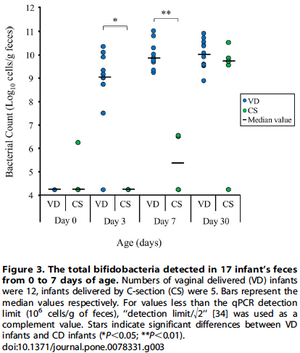The role of Bifidobacterium on the Immune System
Due to Bifidobacterium’s dominance in infant’s fecal flora and as well as its probiotic application, it has experienced a surge in popularity by the medical and science realm to better understand its mechanistic properties and implications in human health concerns. In particular, Bifidobacterium longum has become a subject of more studies as its presence in microflora of infants as well as in adults has been intricately linked to protection against diseases. In addition, because Bifidobacterium is present in up to 90% of the total gut microflora in infants but eventually shifts to about 15% in adults, the study on how colonization of these gram-positive anaerobic bacteria is of particular interest (Ménard, et.al. 2008). Studies often concentrate on the mother-to-infant transmission of bacterial colonization in the gut microflora as more knowledge arises on the initial colonization of the flora and its potential impact on the individual’s future health.
Another concern towards better understanding Bifidobacterium is its application and limitations as a probiotic. Probiotics are living microorganisms that affect the hosting individual in a positive manner by regulating mucosal and systemic immunity as well as fortifying the microbial balance in the intestinal tract (Madsen, 2001). Bifidobacterium is one of the popularly marketed lactic acid bacteria, a category that also includes Lactobacillus and Streptococcus.
The gut microflora is of increasing concern for studies as the manner of colonization displays a complex inter-web all relating to the health of the individual. Thus, it is important to continue studying the microflora in all its aspects as well as paying particular attention to Bifidobacterium effects. In addition, more effort is necessary towards controlling the term “probiotics” in how it is marketed into the marketplace as well as teaching more people about the uses.
Transmission of Bifidobacterium
Increasing knowledge of initial gut colonization show a pattern of facultative aerobes such as Enterobacteriaceae initially colonizing the microflora, essentially setting the path towards colonization from anaerobic bacterias such as Bifidobacterium longum (Makino, et.al. 2013). This pattern in colonization is interesting in sorts because of its implications of the microbial stimulation that can impact various changes to the development of the immune system.
As studies are conducted on the vertical transmission of microbial colonization, factors such as delivery mechanism have come into scrutiny. Makino et.al. observed a vertical transmission of Bifidobacteria, including B. longum, as they were able to obtain and identify the same strains in both mother and infant in vaginally delivered infants (2013). However, studies have indicated that the initial colonization of Bifidobacteria is present particularly only in vaginally delivered infants; with a remarkable difference from those delivered cesarean (Makino et.al., 2013, Miakami, et.al. 2012 and Biasucci, et.al. 2010). Interestingly, several studies have continuously observed B. longum to be a prominent bacterial species that is initially found in the colonization of the newborn microflora.
While there has been an increase in correlation of vertical transmission of Bifidobacterium from mother-to-infant, other non-maternal factors have been observed in the establishment. These factors include breast-feeding or formula feeding as well as horizontal transmission from environmental factors such as the hospital setting (Mikami et.al. 2012).
Section 2
Include some current research in each topic, with at least one figure showing data.
Section 3
Include some current research in each topic, with at least one figure showing data.
Further Reading
[Sample link] Ebola Hemorrhagic Fever—Centers for Disease Control and Prevention, Special Pathogens Branch
References
Edited by (your name here), a student of Nora Sullivan in BIOL168L (Microbiology) in The Keck Science Department of the Claremont Colleges Spring 2014.

